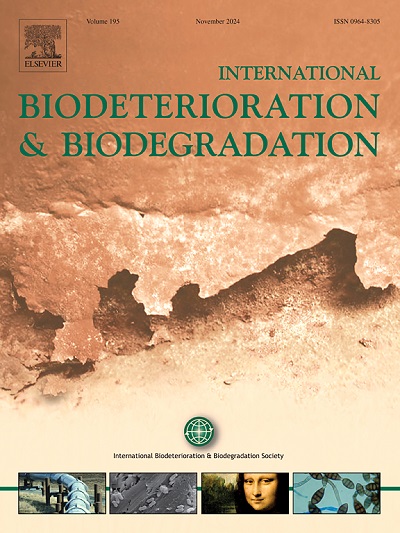人源性谷胱甘肽s -转移酶mu 1介导的硝化纤维素水解:反应机制和热分解行为
IF 4.1
2区 环境科学与生态学
Q2 BIOTECHNOLOGY & APPLIED MICROBIOLOGY
International Biodeterioration & Biodegradation
Pub Date : 2025-06-06
DOI:10.1016/j.ibiod.2025.106139
引用次数: 0
摘要
本研究提出了人源性谷胱甘肽s -转移酶mu 1 (GSTM1)在硝化纤维素(NC)生物催化脱硝中的创新应用,旨在在温和条件下实现硝酸酯水解,同时有效降低NC的有害特性。实验结果表明,GSTM1蛋白在工程大肠杆菌中有异源表达。纯化酶GSTM1处理48 h后,NC的含氮量由12.97%显著降低至8.4%。傅里叶变换红外光谱分析结合纤维素酶对不溶于乙酸乙酯的物质的酶解实验表明,gstm1介导NC中硝酸盐酯基向羟基的转化,并伴随氢键的形成和随后的纤维素再生。凝胶渗透色谱显示,GSTM1处理显著降低了NC的相对分子量,同时拓宽了其分子量分布。此外,扫描电镜图像显示裂纹密度和表面粗糙度增加。TG-DSC和DSC实验证实,NC处理后燃烧热降低,活化能(Ea)从195.92 kJ·mol−1降至168.47 kJ·mol−1。采用无模型Friedman方法对反应前后NC的热分解过程进行了深入分析。通过系统优化,确定了理想的酶促反应参数为3.2 g·L−1 NC底物浓度与1.0 g·L−1 GSTM1在37℃条件下反应8 h。该新技术安全环保地处理军用废物,同时为开发基于NC的多酶协同系统处理废物提供了新的见解。本文章由计算机程序翻译,如有差异,请以英文原文为准。

Human-derived glutathione S-transferase mu 1 mediated hydrolysis of nitrocellulose: reaction mechanisms and thermal decomposition behavior
This study proposes the innovative application of human-derived glutathione S-transferase mu 1 (GSTM1) for biocatalytic denitration of nitrocellulose (NC), designed to achieve nitrate ester hydrolysis under mild conditions while effectively reducing NC's hazardous properties. The experimental results showed that GSTM1 protein was expressed heterologously in engineered Escherichia coli (E. coli). After 48 h of treatment with purified enzyme GSTM1, the nitrogen content of NC significantly decreased from 12.97 % to 8.4 %. Fourier transform infrared spectroscopic analysis combined with cellulase enzymatic hydrolysis experiments of substances insoluble in ethyl acetate demonstrated GSTM1-mediated conversion of nitrate ester groups to hydroxyl groups in NC, accompanied by hydrogen bond formation and subsequent regeneration of cellulose. Gel permeation chromatography revealed that GSTM1 treatment significantly reduced the relative molecular weight of NC while broadening its molecular weight distribution. Moreover, scanning electron microscopy images revealed increased crack density and surface roughness on NC fiber. The TG-DSC and DSC experiments confirmed decreased combustion heat and reduced activation energy (Ea) from 195.92 kJ·mol−1 to 168.47 kJ·mol−1 post-treatment of NC. The thermal decomposition process of NC before and after the reaction was thoroughly analyzed using the model-free Friedman method. Through systematic optimization, the ideal enzymatic reaction parameters were established as 3.2 g·L−1 NC substrate concentration with 1.0 g·L−1 GSTM1 at 37 °C for 8 h. This novel technique safely and environmentally friendly treats waste military compounds while offering new insights for developing multi-enzyme synergistic systems for NC-based waste treatment.
求助全文
通过发布文献求助,成功后即可免费获取论文全文。
去求助
来源期刊
CiteScore
9.60
自引率
10.40%
发文量
107
审稿时长
21 days
期刊介绍:
International Biodeterioration and Biodegradation publishes original research papers and reviews on the biological causes of deterioration or degradation.

 求助内容:
求助内容: 应助结果提醒方式:
应助结果提醒方式:


